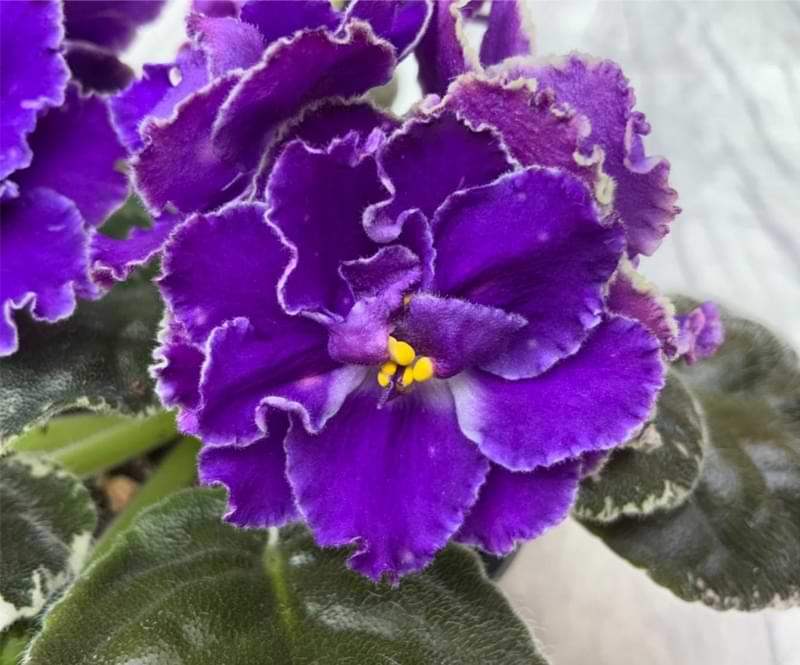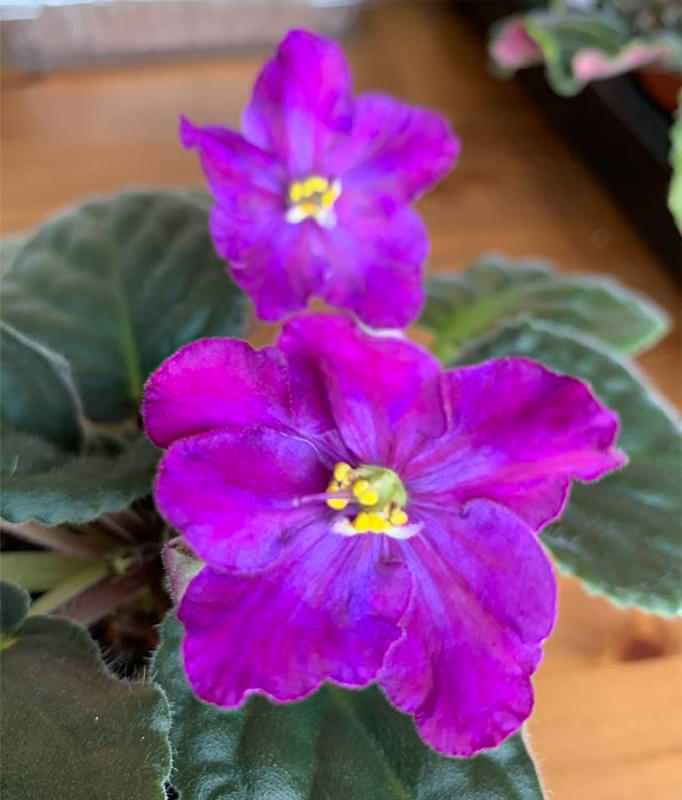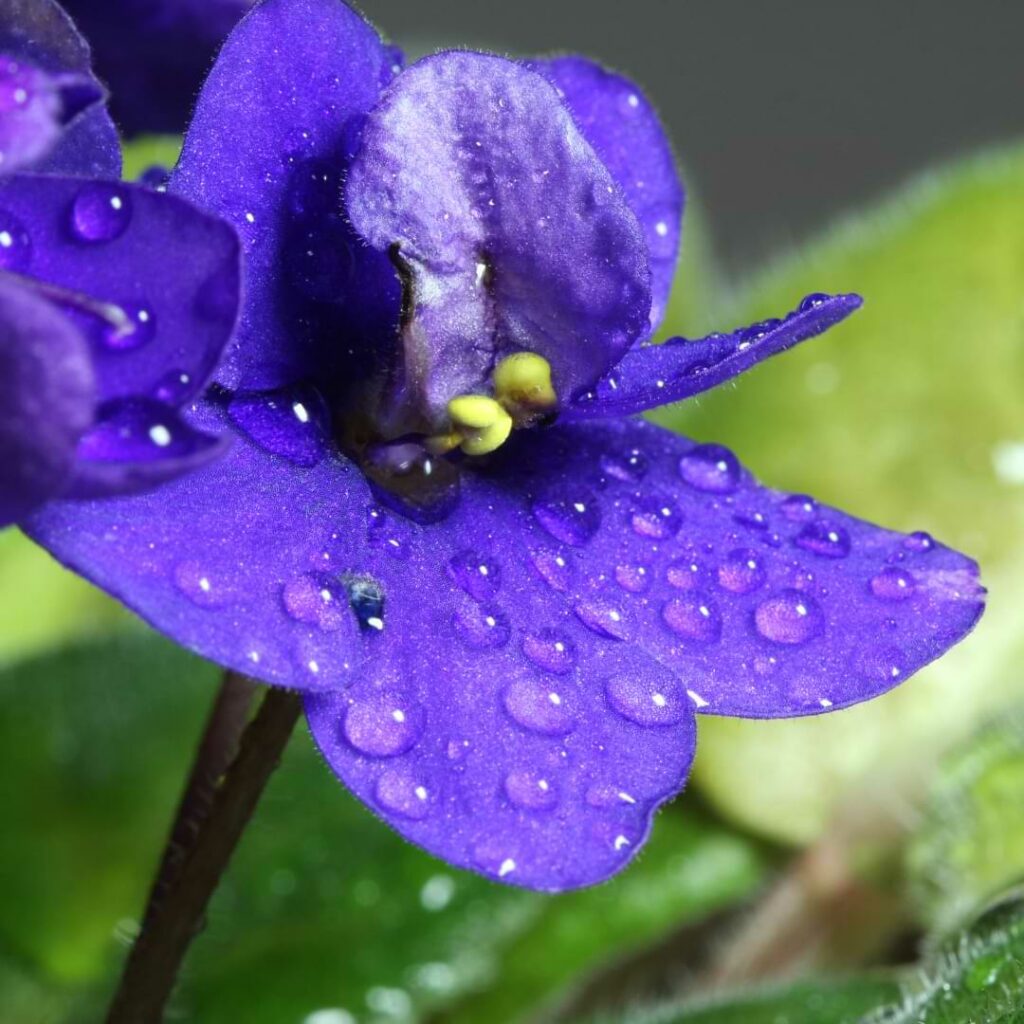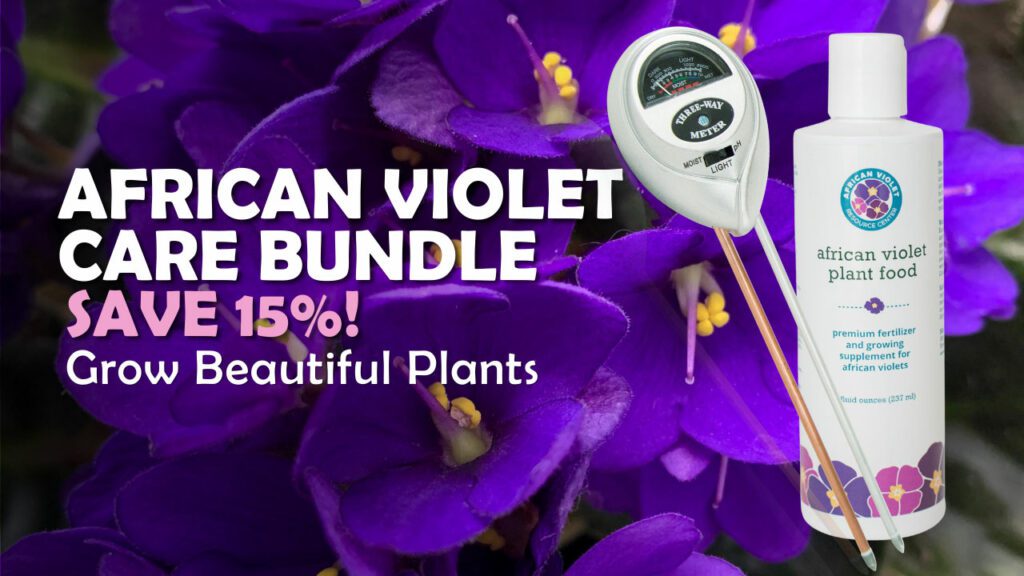Are you a fan of vibrant, eye-catching blooms? Then you’re going to fall in love with these purple African Violets! These small but stunning plants come in a wide variety of shades and shapes that will add an instant pop of color to any space, so let’s take a look at some and see if we can find a favorite!
12 Types of Purple African Violets
Myakka Trail
Myakka Trail is a stunning purple African violet that boasts beautiful ruffled petals and bright green leaves. Its blooms are large and long-lasting, making it a favorite among collectors.
This African Violet usually blooms all year round, and can grow up to 12 inches in height and spread. What sets Myakka Trail apart from other African violets is its ability to tolerate low light conditions. It thrives in partial shade but can also handle bright indirect light. This makes it an ideal choice for indoor growers who may not have access to direct sunlight.
Cherry Princess
Cherry Princess is a stunning African Violet with gorgeous purple flowers that have a cherry-red center. This hybrid plant was developed by crossing two species of African Violets and has become very popular among violet enthusiasts.
One of the most striking features of Cherry Princess is its unique flower coloration, which makes it stand out from other violets in any collection. The petals are a soft lavender hue, while the center spot is a bright red shade reminiscent of sweet cherries.
Aside from its beautiful blooms, Cherry Princess also boasts an attractive foliage that has round leaves with slightly fuzzy textures. The leaves are deep green in color and complement the flowers perfectly.
Devotion
Devotion is a stunning purple African violet that blooms with large, showy flowers. This variety has double-bloom flowers and its petals are a rich shade of deep purple with darker veins. Its leaves are dark green and fuzzy, adding to the charm of this plant.
One of the unique features of Devotion is its long-lasting blooms. With proper care, these flowers can last for several weeks or even months before fading away. Devotion prefers bright but indirect light and should be kept in temperatures between 60-80°F. It needs consistent moisture but not overly wet soil, so make sure to water it regularly without letting it sit in standing water.

Summer Twilight
Summer Twilight is a stunning African violet that boasts beautiful purple flowers with white edges. The soft pastel colors of this plant’s blooms are sure to brighten up any room in your home or office. Its small size and compact growth make it an ideal indoor plant. This cultivar was first introduced in 1996 by Lyndon Lyon Greenhouses.
Nightfall
Nightfall is one of the most stunning purple African violets you could ever come across. This cultivar produces large, velvety leaves that are a deep shade of green and set off perfectly by its striking purple flowers. It is a large African Violet variety, so it can grow to be 12 inches in width and height, possibly even more.
The blooms on Nightfall are stunning. They have a rich, dark color with ruffled edges that give them an almost regal appearance. The petals themselves curl slightly inward which only adds to their unique beauty. What’s more, Nightfall can produce multiple blooms per stem making it even more impressive when in full bloom!

Amethyst
Amethyst is a beautiful and unique type of African violet that features stunning purple flowers. It gets its name from the precious gemstone, amethyst, which is also known for its deep purple color. The flowers bloom in clusters on top of long stems that rise above the foliage. When in full bloom, these violets create an impressive display that can brighten up any room.
In addition to their beauty, Amethyst African violets are relatively easy to care for and grow well in most environments. They don’t have different care requirements than other African Violet varieties.
Peacock
Peacock is a beautiful African violet variety with stunning purple flowers that have dark blue edges. The blooms are semi-double, meaning they have more petals than the standard single-flowered violets.
The leaves of Peacock are quite striking as well, with vibrant green color and a slightly ruffled texture. The plant itself has a compact growth habit, making it perfect for small spaces or window sills.
One thing to note about Peacock is that its flowers may fade in intense heat or direct sunlight. To prevent this from happening, move the plant to a cooler location or provide some shade during the hottest parts of the day.
Mac’s Jubilant Jamboree
Mac’s Jubilant Jamboree is a popular variety of African violets with purple flowers that bloom in the summer. This plant has beautiful deep green leaves that complement the vibrant purple blooms. It is a semi-miniature African Violet, so it will typically stay between 6-8 inches tall and wide.
A big advantage of this violet is that it can tolerate slightly cooler temperatures than other types of African violets, making it ideal for homes or offices with lower ambient temperatures.
Little Intermezzo
Little Intermezzo is a stunning African violet that belongs to the semi-miniature category. This cultivar boasts gorgeous purple-pink blooms with white edges and deep green foliage, making it a standout addition to any indoor garden.
What sets Little Intermezzo apart from other African violets is its ability to bloom prolifically throughout the year. With proper care and maintenance, this plant can produce up to three or four flushes of flowers annually.
Lonestar Twilight
Lonestar Twilight is a stunning variety of African violet with purple flowers that bloom in abundance. This cultivar has beautiful, velvety petals and striking white centers.
What sets Lonestar Twilight apart from other African violets is its unique coloration. The deep purple hue of the blooms fades into a lighter lavender towards the center, creating an ombre effect that truly catches the eye.
Beyond its beauty, Lonestar Twilight also has impressive growth patterns. This plant tends to grow tall and upright rather than spreading out like some other varieties, and as a standard sized African Violet, will produce plenty of stunning blooms. Its leaves are dark green and glossy, providing a lovely contrast to the vibrant blooms.
First Kiss Blush
The petals of this plant have a unique blush pink coloration with only splashes of deep purple here and there, which makes it stand out from other varieties. First Kiss Blush grows up to six inches tall and produces blooms throughout the year, making it an excellent choice for indoor gardening.
One of the best things about this plant is its ability to thrive in different lighting conditions. It can do well under artificial light or near a window with indirect sunlight. However, too much direct sun exposure can damage its leaves.
Julia
Julia is a beautiful purple African Violet with deep, richly pigmented flowers. Its blooms are large and showy, making it a popular choice among indoor gardeners who want to add some color to their space. Amazingly, this plant can produce multiple flower stalks at once. This means that you can enjoy several blooms on one plant simultaneously, which adds even more visual interest to your indoor garden.
Another interesting thing about Julia is its size. It’s considered a miniature African violet, which means that it grows up to 6 inches tall and wide. This makes it an excellent choice for small spaces or as part of a larger arrangement with other houseplants.
Purple African Violets Growing Guide
Having purple African Violets in the home is an excellent way to bring beauty and color into your space, so here’s a guide to help you grow your African Violet, including some things you can expect as these plants grow.
Height and Spread
The height and spread of the plant varies depending on the type. Some types grow taller than others while some remain small and compact. Generally speaking, most African violets will grow to be between 6 and 12 inches in both height and spread. African violet sizes are further broken down into size categories:
Miniature: These plants typically grow to be 6 inches or less in height and spread. Because of their small size, they may require more care and attention than other varieties.
Semi-miniature: Semi-miniature African Violets grow to be between 6 and 8 inches in height and spread.
Standard: Standard sized African Violets grow to be between 8 and 16 inches in height and spread.
Large: Large African Violets are any that grow more than 16 inches.
It’s important to keep in mind that these plants prefer tight spaces so don’t be alarmed if they begin growing close together or even touching each other. This may actually help them thrive as they provide natural humidity for one another.
Seasonality and Lifespan
Purple African violets can bloom year-round. However, there are certain factors that may affect their blooming schedule, as well as their general lifespan.
The seasonality of purple African violets depends on their environment and care. Our comprehensive care guide below will outline how to keep your African Violet happy for years to come.
With proper care, purple African violets can live for several years. Their average lifespan is about three years but some have been known to live past ten years! Regular care will ensure your African Violet gets to live a nice, long life.
Blooms
African Violet blooms are one of the most-loved parts of the African Violet plant. Most African Violet varieties are ever-blooming, meaning they can bloom all year round with no breaks.
The best way to get continuous blooms from your African Violet is by keeping the plant on a regular fertilizer schedule, providing the plant with enough indirect sunlight, giving it enough water, and most importantly, ensuring the plant gets at least 8-10 hours of darkness every single day. This period of darkness sends signals to the plant to produce flowers, so it is crucial if you want to enjoy beautiful blooms all year.
How to Care For Purple African Violets
Purple African Violets are low-maintenance plants that will thrive as long as you give it the proper care it needs. Here’s a guide that includes everything from watering your AV to finding the right fertilizer for it, and more.
Light
Place your violet in a bright but indirect light source. Windows facing north or south are ideal if the plant is going to be placed close to it. Windows facing east are arguably the best for an African Violet, so long as they don’t get direct light from the morning sun. West-facing windows are good for African Violets as long as they are placed somewhere the direct sun rays can’t reach it.
Watering
Water your plant when the soil feels dry to the touch. Using a moisture meter will help you avoid watering too often or letting the soil dry out too much. Dry soil is hard to re-moisten, which can cause problems with your African Violet’s growth and blooms.
Avoid getting water on the leaves as it can cause damage. The best way to prevent water damage on the leaves is to water your plant right at the soil, under all the foliage using a long-necked watering can.
Humidity
The ideal humidity level for African Violets is 80%, and while that may be difficult to achieve inside a home, there are easy ways to increase humidity around your AV. Consider using a humidifier or placing them on top of a humidity tray filled with pebbles and water. You can also place other houseplants near your African Violet, or mist the air around your AV regularly throughout the day.
Soil
Use well-draining soil specifically formulated for African Violets to ensure their roots do not become too wet or dry. This is one of the most important factors when caring for your African Violet, because they are prone to root rot, which can kill your beautiful plant quickly.

Fertilizer
With these delicate plants, steer clear of regular plant fertilizers. Instead, opt for a plant food that is made specifically for African Violets, which will ensure that your plant gets all the right nutrients every time you water it, instead of drowning it with nutrients once every two to three weeks.
Repotting
Once per year, repot your violet into fresh soil in a slightly larger pot until it reaches its mature height and spread. Once it does, you can either just top-dress your plant with new soil, or you can completely replace the existing soil, but without having to up-pot into a bigger pot.
Are Purple Violets Toxic
African violets are not toxic to humans or pets, so you can safely display them in your home without any concerns. It’s still not a good idea to allow pets or people to pick at or eat the foliage or blooms, only because it could cause stomach upset or possibly even digestive blockages.
FAQs Purple Flowered African Violets
How many types of African violets are there?
There are currently over 16,000 types of African Violets, and more are being developed by botanists and African Violet enthusiasts every year.
Join the African Violet Club!
Whether you’re just starting out or are a seasoned grower, African Violet Resource Center has everything you need to help your plant grow vibrant and strong. Explore our other articles, visit our online shop, and connect with other houseplant lovers in our Facebook group to learn everything you need to know about this rewarding hobby!
More Great African Violet Resources
Stayin’ Alive! A Beginner’s Guide to African Violet Care
Everything You Need to Know About African Violet Leaves







